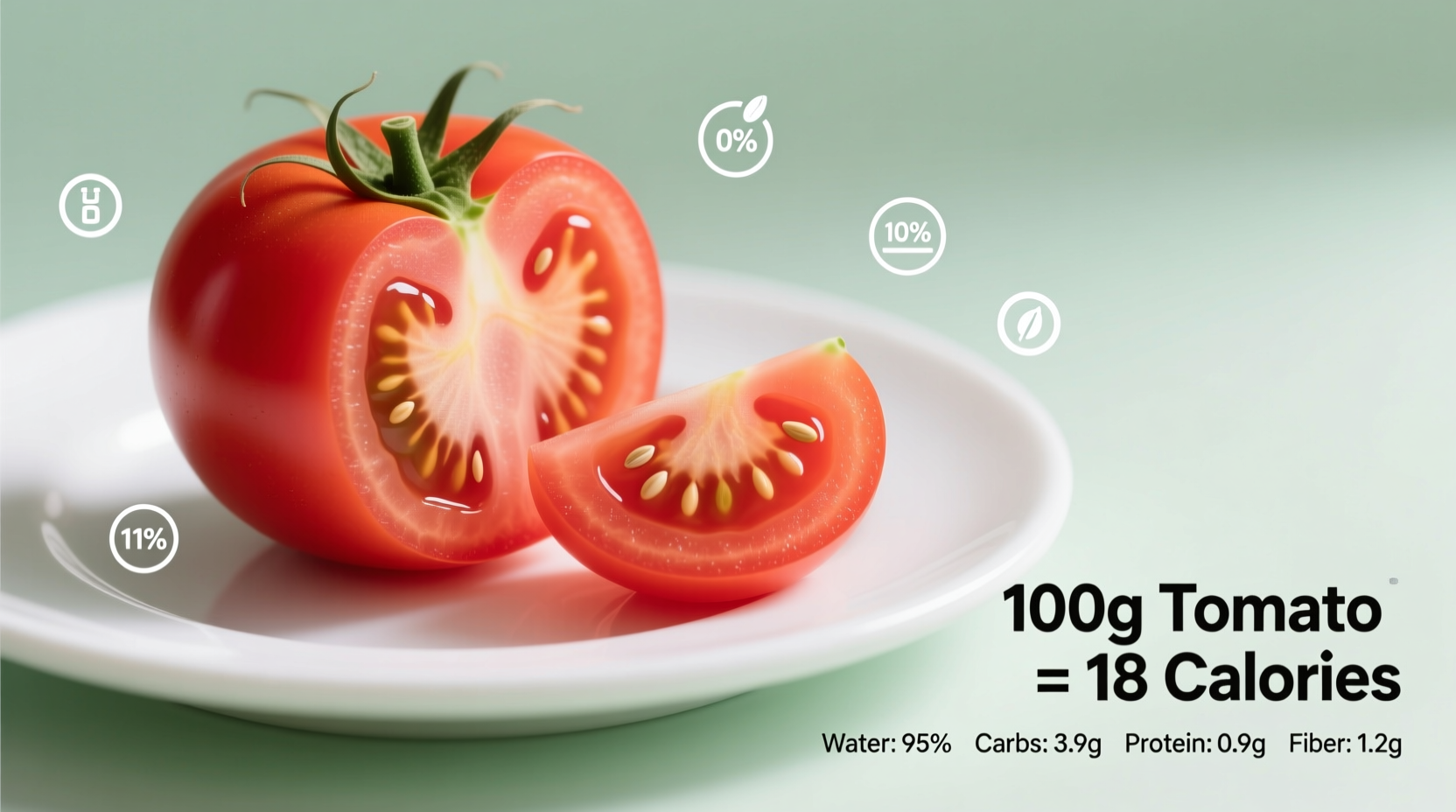When tracking your daily nutrition, knowing the exact calorie content of common foods is essential. Tomatoes rank among the most versatile and nutrient-dense produce options available, offering remarkable health benefits with minimal caloric impact. Whether you're monitoring your weight, managing dietary restrictions, or simply aiming for healthier eating habits, understanding the precise nutritional profile of tomatoes helps you make informed food choices.
Tomato Calorie Content by Variety and Serving Size
While the standard medium tomato contains about 22 calories, different varieties and preparation methods affect the total calorie count. The USDA FoodData Central database provides the most reliable nutritional information for various tomato types:
| Tomato Type | Standard Serving | Calories | Carbohydrates (g) | Fiber (g) |
|---|---|---|---|---|
| Raw medium tomato | 123g | 22 | 4.8 | 1.5 |
| Cherry tomatoes | 100g (about 10-12) | 18 | 3.9 | 1.2 |
| Roma tomatoes | 123g | 21 | 4.6 | 1.9 |
| Cooked tomatoes | 100g | 29 | 6.5 | 1.3 |
| Sun-dried tomatoes | 28g (¼ cup) | 78 | 17.5 | 4.0 |
This nutritional comparison reveals why fresh tomatoes consistently rank as one of the most diet-friendly produce options. The slight increase in calories for cooked tomatoes comes from water reduction during cooking, which concentrates nutrients and natural sugars. Sun-dried tomatoes show significantly higher calorie density due to the removal of approximately 90% of their water content.
Understanding Tomato Nutrition Beyond Calories
Tomatoes offer far more than just low-calorie content. They're packed with essential nutrients that contribute to overall health while keeping your calorie count in check. A medium tomato provides approximately:
- 40% of your daily vitamin C needs
- 20% of your recommended vitamin K
- 15% of your daily potassium requirement
- Significant amounts of vitamin A and folate
- Lycopene, a powerful antioxidant responsible for tomatoes' red color
According to research published by the National Institutes of Health, lycopene absorption increases when tomatoes are cooked or processed, making tomato sauce and paste valuable additions to a healthy diet despite their slightly higher calorie concentration.

Practical Ways to Incorporate Tomatoes Into Your Diet
With their minimal calorie impact and impressive nutrient profile, tomatoes deserve a regular place in your meal planning. Consider these practical applications:
For Weight Management
Add sliced tomatoes to sandwiches instead of higher-calorie options like cheese or avocado. A cup of diced tomatoes adds just 32 calories while providing volume and hydration that helps you feel full longer. The high water content (approximately 95%) makes tomatoes an excellent choice for those seeking to reduce overall calorie density in meals.
For Meal Enhancement
Tomatoes naturally enhance flavor without adding significant calories. Instead of reaching for high-calorie dressings or sauces, try roasting cherry tomatoes with herbs to create a flavorful base for proteins or grains. The natural sweetness that develops during roasting satisfies cravings without added sugars.
Understanding Serving Size Context
When tracking calories, it's crucial to understand realistic serving sizes. Many people underestimate portions of cherry or grape tomatoes, which can add up quickly. While 100g of cherry tomatoes contains only 18 calories, consuming a full pint (approximately 300g) would total around 54 calories. This remains relatively low compared to many snack options, but awareness helps maintain accurate tracking.
Common Misconceptions About Tomato Calories
Several myths persist about tomato nutrition that deserve clarification. Some believe that all processed tomato products are high in calories, but this isn't universally true. Unsweetened tomato juice contains about 41 calories per 8-ounce serving, while tomato paste has approximately 66 calories per ¼ cup. The key difference lies in added sugars and oils in commercial products.
Another misconception suggests that different colored tomatoes have significantly different calorie counts. While heirloom varieties may vary slightly in sugar content, the caloric difference between red, yellow, and orange tomatoes remains minimal—typically within 2-3 calories per standard serving.
Tomatoes Through Agricultural Evolution
Modern tomato varieties have evolved significantly from their wild ancestors. Historical analysis from agricultural research shows that centuries of selective breeding have increased both size and sugar content while maintaining remarkably low calorie density. Wild tomatoes contained higher concentrations of certain alkaloids but were significantly smaller, with modern cultivation producing larger fruit while keeping calorie density consistently low.
According to data from the USDA FoodData Central, contemporary tomato varieties maintain similar nutritional profiles despite size differences, with calorie content scaling proportionally to weight rather than variety type. This consistency makes tomatoes a reliable option for precise nutritional tracking.
Maximizing Nutritional Benefits While Tracking Calories
To get the most nutritional value from tomatoes while monitoring your calorie intake, consider these evidence-based strategies:
- Pair tomatoes with healthy fats like olive oil to increase lycopene absorption without significantly impacting your daily calorie goals
- Choose vine-ripened tomatoes when possible, as research indicates they contain higher concentrations of certain antioxidants
- Include both raw and cooked tomatoes in your diet to benefit from different nutrient profiles
- Be mindful of added ingredients in tomato-based dishes that can substantially increase calorie content
Remember that the natural acidity in tomatoes helps with mineral absorption from other foods, making them valuable components of balanced meals beyond their standalone nutritional profile.











 浙公网安备
33010002000092号
浙公网安备
33010002000092号 浙B2-20120091-4
浙B2-20120091-4